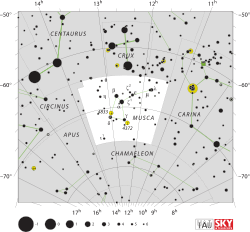Beta Muscae

Location of β Musca (circled) | |
| Observation data Epoch J2000.0 Equinox J2000.0 (ICRS) | |
|---|---|
| Constellation | Musca |
| Right ascension | 12h 46m 16.80410s[1] |
| Declination | –68° 06′ 29.2164″[1] |
| Apparent magnitude (V) | 3.05 (3.51 + 4.01)[2] |
| Characteristics | |
| Spectral type | B2 V + B3 V[2] |
| U−B color index | –0.766[3] |
| B−V color index | –0.198[3] |
| Astrometry | |
| Radial velocity (Rv) | +42[4] km/s |
| Proper motion (μ) | RA: –41.97[1] mas/yr Dec.: –8.89[1] mas/yr |
| Parallax (π) | 9.55 ± 0.41[1] mas |
| Distance | 340 ± 10 ly (105 ± 4 pc) |
| Orbit[5] | |
| Period (P) | 194.28 yr |
| Semi-major axis (a) | 0.969" |
| Eccentricity (e) | 0.598 |
| Inclination (i) | 37.1° |
| Longitude of the node (Ω) | 349.4° |
| Periastron epoch (T) | 1857.50 |
| Argument of periastron (ω) (secondary) | 209.0° |
| Details | |
| β Mus A | |
| Mass | 7.35[6] M☉ |
| Age | 15.1 ± 1.2[7] Myr |
| β Mus B | |
| Mass | 6.40[6] M☉ |
| Other designations | |
Beta Muscae (β Muscae, β Mus) is a binary star in the southern circumpolar constellation of Musca. With a combined apparent visual magnitude of 3.07,[2] it is the second brightest star (or star system) in the constellation. Judging by the parallax results, it is located at a distance of roughly 330–350 light-years (100–110 parsecs) from the Earth.[1]
This is a binary star system with a period of about 194 years at an orbital eccentricity of 0.6.[5] As of 2007, the two stars had an angular separation of 1.206 arcseconds at a position angle of 35°.[6] The components are main sequence stars of similar size and appearance. The primary component, β Muscae A, has an apparent magnitude of 3.51, a stellar classification of B2 V,[2] and about 7.35 times the Sun's mass.[6] The secondary component, β Muscae B, has an apparent magnitude of 4.01, a stellar classification of B3 V,[2] and is about 6.40 times the mass of the Sun.[6]
This is a confirmed member of the Scorpius-Centaurus Association,[2][6] which is a group of stars with similar ages, locations, and trajectories through space, implying that they formed together in the same molecular cloud. Beta Muscae is considered a runaway star system as it has a high peculiar velocity of 43.9 km s–1 relative to the normal galactic rotation. Runaway stars can be produced through several means, such as through an encounter with another binary star system. Binary systems form a relatively small fraction of the total population of runaway stars.[9]
References
- ↑ 1.0 1.1 1.2 1.3 1.4 1.5 van Leeuwen, F. (November 2007), "Validation of the new Hipparcos reduction", Astronomy and Astrophysics 474 (2): 653–664, arXiv:0708.1752, Bibcode:2007A&A...474..653V, doi:10.1051/0004-6361:20078357
- ↑ 2.0 2.1 2.2 2.3 2.4 2.5 Eggleton, P. P.; Tokovinin, A. A. (September 2008), "A catalogue of multiplicity among bright stellar systems", Monthly Notices of the Royal Astronomical Society 389 (2): 869–879, arXiv:0806.2878, Bibcode:2008MNRAS.389..869E, doi:10.1111/j.1365-2966.2008.13596.x
- ↑ 3.0 3.1 Gutierrez-Moreno, Adelina; Moreno, Hugo (June 1968), "A Photometric Investigation of the Scorpio-Centaurus Association", Astrophysical Journal Supplement 15: 459, Bibcode:1968ApJS...15..459G, doi:10.1086/190168
- ↑ Wilson, Ralph Elmer (1953). General Catalogue of Stellar Radial Velocities. Washington: Carnegie Institution of Washington. Bibcode:[http://adsabs.harvard.edu/abs/1953QB901.W495..... 1953QB901.W495.....]
- ↑ 5.0 5.1 "Sixth Catalog of Orbits of Visual Binary Stars", U.S. Naval Observatory, retrieved 2008-06-22
- ↑ 6.0 6.1 6.2 6.3 6.4 6.5 Kouwenhoven, M. B. N.; Brown, A. G. A.; Portegies Zwart, S. F.; Kaper, L. (October 2007), "The primordial binary population. II. Recovering the binary population for intermediate mass stars in Scorpius OB2", Astronomy and Astrophysics 474 (1): 77–104, arXiv:0707.2746, Bibcode:2007A&A...474...77K, doi:10.1051/0004-6361:20077719
- ↑ Tetzlaff, N.; Neuhäuser, R.; Hohle, M. M. (January 2011), "A catalogue of young runaway Hipparcos stars within 3 kpc from the Sun", Monthly Notices of the Royal Astronomical Society 410 (1): 190–200, arXiv:1007.4883, Bibcode:2011MNRAS.410..190T, doi:10.1111/j.1365-2966.2010.17434.x
- ↑ "CCDM J12463-6806AB -- Double or multiple star", SIMBAD (Centre de Données astronomiques de Strasbourg), retrieved 2012-01-20
- ↑ Hoogerwerf, R.; de Bruijne, J. H. J.; de Zeeuw, P. T. (January 2001), "On the origin of the O and B-type stars with high velocities. II. Runaway stars and pulsars ejected from the nearby young stellar groups", Astronomy and Astrophysics 365: 49–77, arXiv:astro-ph/0010057, Bibcode:2001A&A...365...49H, doi:10.1051/0004-6361:20000014
External links
- Kaler, James B., "Beta Muscae", Stars (University of Illinois), retrieved 2012-01-20
| ||||||||||||||||||||||||||||